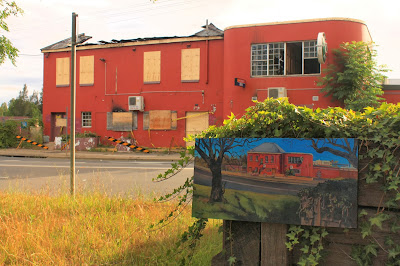Built in the 1870s,it closed in the early 1990s when the CSR refinery and distillery were progressively shut down and demolished to make way for the Jackson's landing development. Since then, it has been renovated as retail outlets, restaurants and home units.

P248 The 'Pyrmont Arms' from the CSR 1
1990 oil on canvas 31 x 31cm
I first painted the Pyrmont Arms Hotel as a bird's eye view from the roof of the CSR refinery.I had been the 'Artist in Residence' at the CSR Refinery from the late 1980s to the start of its demolition in the mid 1990s. I had previously been painting at the top of the Panhouse, but one day in a fit of bravery I decided to paint from the top of the Boilerhouse next to the chimneys.
The CSR boilerhouse is now the site of the 'Elizabeth' apartment block of the Jackson's Landing LendLease development.
The Pyrmont Arms Hotel was then still an operating pub and was painted a grubby faded pale pinkish beige. On the back of the pub's western side facing the Scott Street squats, there was a huge ad for 'Have a cold gold KB', unfortunately not visible from my rooftop studio. Across the road was the brick facade of the CSR chem labs.
It didn't stand out from the rest of the rather dingy terraces at the 'Land's End' of Harris street, but what caught my eye was the contrast between the terraces and the overgrown area around the squats that was rapidly turning into a wilderness. I painted a small square canvas focussing on just the Pyrmont Arms, and resolved one day to paint a panorama of the northern end of Harris Street from this vantage point.

P249 'Pyrmont panorama- from the CSR '
1991 oil on canvas 46 x 92cm
A few months later, I climbed the many levels of revolting, sugar syrup encrusted stairs to the top of the CSR boilerhouse again, to paint this panorama, and was startled to find that the formerly almost unnoticeable pub had succumbed to a brash attempt at 'renovation'.
Weirdly, it shared the same revolting shade of pink with another dying pub at the other end of Pyrmont, the 'New York Hotel' in Edward Street, opposite the Pyrmont Power Station.
This fluoro paint job was such a product of its time that it defined the late 1980s to 1990s, a period without style or taste. I remember leggings and jumpers in that same fabulously horrid "glow in the dark" colour, possibly an over-reaction against the ochres and browns of the 1970s. In architecture, it was known not very fondly as "Paddington Pink" or "Paddo pink" for short, although the examples in Paddington itself were much more muted.

P248B 'The 'Pyrmont Arms' from the CSR 2'
1991 oil on canvas 31 x 31cm
It made the Pyrmont Arms stick out like a sore thumb from the dingy red brick warehouses and bond stores, and not in a good way.
I don't know if it was still an operating pub then or whether the new paint job was a desperate last ditch attempt to attract customers or preparation for its sale and possible redevelopment.
For the truth was that the pubs of Pyrmont were hanging by a thread. Their customers were gone with the destruction or relocation of the local industries that had employed them, and the industries of Pyrmont's future were yet to replace them.
The CSR Refinery and Distillery, which had replaced the sandstone quarrymen of northern Pyrmont a century before, was almost deserted and would be demolished and replaced with Jackson's Landing by the middle of the decade. But there was a strange interregnum before the new apartments were built and filled with inhabitants, and the northern end of Harris Street was a ghost town.
The iconic Terminus Hotel, only 2 blocks further up Harris Street, had already ceased trading a decade before, and stood abandoned, neglected and a constant source of speculation for the next 30 years, before its very recent renovation. How the 'Royal Pacific', later to be rechristened the 'Pyrmont Point'/ 'Point Hotel', ever kept on trading is a much bigger mystery that any of the urban myths swirling around the 30 year vacancy of the Terminus.
What is it with the lurid colour schemes inflicted on moribund pubs?
Far from Pyrmont, another doomed hotel, the 'Jolly Frog' also got the pink treatment not long before it suffered one of those mysterious fires that afflict abandoned buildings.
They must have used the same colourblind painter and decorator. And he must have got the paint at a huge discount, or it might have 'fallen off the back of a truck'.
Either way, it didn't work. All closed as pubs not long after.

P248C '42 Harris st -ex Pyrmont Arms'
2012 oil on canvas 31 x 31cm
The 'New York Hotel' has been painted a tasteful off-white, and is now a medical centre, of all things!
'The Pyrmont Arms' has now been painted a dull blue on the ground floor and a muted yellow for the upper floors. It is no longer a hotel, but has been reasonably sympathetically renovated and is now a combination of apartments above and a bottle-o below.
And the Jolly Frog, 6 years after its devastating fire, is still awaiting redevelopment.
Related Posts















